Introduction
Business Process Management has become increasingly more important in recent years. Digitalization and the need to respond flexibly to changing market conditions have forced companies to rethink and drastically redesign their processes.
However, how significant is BPM truly for companies? To what extent is BPM being practiced? How important are professional BPM tools? What hurdles and challenges does Process Management face, and how are the future forecasts? These, and other questions are addressed in a current BPM study created by the Institute of Information Systems at the ZHAW School of Management and Law in collaboration with BOC Group. It summarizes the responses of more than 300 survey participants from companies of different sizes and various industries.
In the following article, we address the five most important findings of the study and provide an overview of current trends and developments in process management. You can download the complete BPM study here.

Tim Geppert and Björn Scheppler
(ZHAW School of Management and Law)
Since when is BPM actively practiced in companies
When asked for how long companies have been actively practicing process management, there are remarkable differences depending on the size of the company. While one-third of SMEs (29%) have already been operating BPM for five or more years, the figures are twice as high (60%) for companies with more than 1,000 employees. In addition, 47% of SMEs have not yet implemented BPM for more than 3 years, while this number is at only 23% for companies with 1,000+ employees.

The development stages of process management in organizations
Participants were asked about the development stage of their Business Process Management practices. The results provide insights into the status quo of BPM in organizations and how it has evolved since 2011.
Over the period from 2011 to 2022, the overall BPM maturity level has improved. A significant decrease in the number of companies in Stage 1 and an increase in the number of companies in Stage 4 indicate that there is progress in implementation.
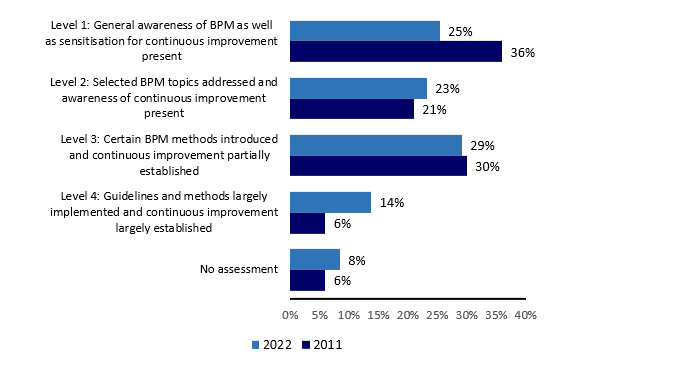
The analysis clearly reveals that the companies are positioned quite differently in terms of their BPM development stages. The proportion of companies in stages 1 to 3 is almost equally distributed, which means that the companies are at different stages of BPM implementation. Stage 4, which involves introducing BPM and establishing a continuous improvement process (CIP), represents a particularly challenging hurdle. 14% of the companies said that they have reached this stage.
The most popular software-based process modeling tools: an overview
Tools that specialize in process management, such as BPM suites and database-driven graphical modelling tools, are commonly used for modelling, followed by drawing systems such as Microsoft Visio. However, over the past eight years, there has been a significant decline in the use of drawing systems like Microsoft Office (-20%) for process modelling.
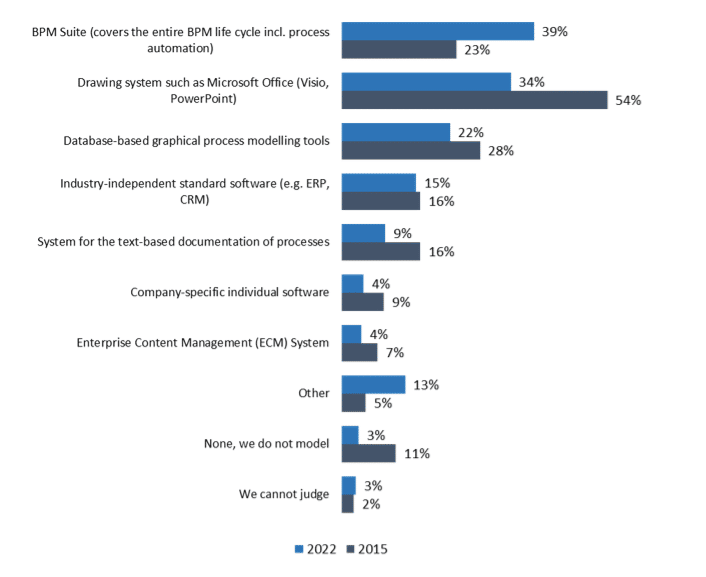
More and more companies rely on specialized BPM suites or other software. In our webinar and accompanying criteria catalogue, you will find a list of criteria as well as best practices to help you select a suitable BPM tool for your needs. The survey results also indicate that fewer processes are documented in the form of texts and that less company-specific individual software (-5%) is used for modelling.
The number of companies that do not perform any process modelling at all has also dropped significantly.
Future importance of software-based BPM tools in organizations
The survey reveals that 89% of respondents rate the importance of BPM tools, such as our Gartner Customer Choice winner BPM tool ADONIS, as constant or increasing. Small and midsize companies even seem to rate the importance of BPM tools slightly higher in comparison to large companies. Over time, there is also a slight increase in the importance of BPM tools (+5% since 2011).
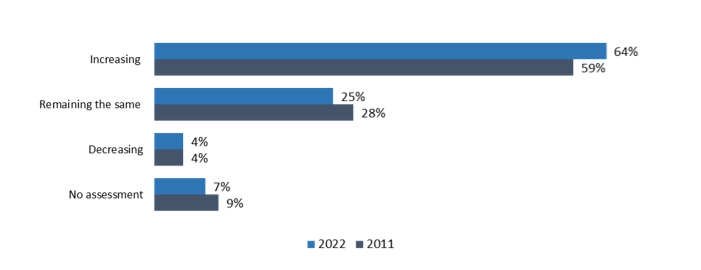
The main challenges of BPM in organizations
The biggest challenge in the area of BPM is clearly the lack of resources and personnel, as confirmed by 67% of respondents. In addition, there are difficulties with training (42%), lack of know-how (29%), and definitions and compliance with modelling standards (19%).
Recommendation: In our webinar on Process Modelling we share with you our best practices to model your business processes efficiently and effectively.

In addition to these challenges, there are other issues associated with establishing BPM in an organization. Although acceptance in the company (see question: since when has BPM been practiced) is quite good, 48% of respondents state that there is still room for improvement here. One effective way to increase the acceptance of process management in the company is to encourage employee engagement. This measure can help to ensure that process management is more widely accepted in the company and implemented successfully.
If you would like to learn about successful strategies to help you increase adoption and engagement in your process management initiatives, we recommend our blog post on how to promote BPM.
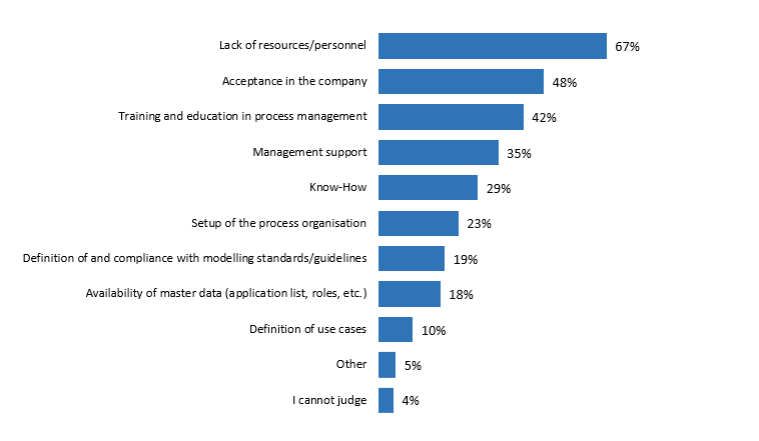
35% of respondents also criticize the lack of support from management, while another 23% consider the setup of the process organization to be challenging, 10% of participants also expressed concerns on the process documentation practice. In order to successfully establish BPM in your organization, it is crucial to gain management support. One way to get management more involved in the process is to provide reporting that includes relevant key performance indicators. This way, decision makers can make better-informed decisions based on up-to-date data, making BPM more effective. If you would like to know how our BPM suite ADONIS, can help you with your data analysis and reporting needs, we recommend the following webinar.
Future of process management: assessments of relevance development
According to the BPM study, 68% of respondents estimate that the future relevance of BPM in companies will be increased or greatly increased in the upcoming years. A total of 96% assume that the relevance of process management in companies will at least remain the same.

This result highlights the importance of process management as a managerial discipline. Interestingly, respondents from SMEs (250-999 employees) expect the strongest increase in relevance.
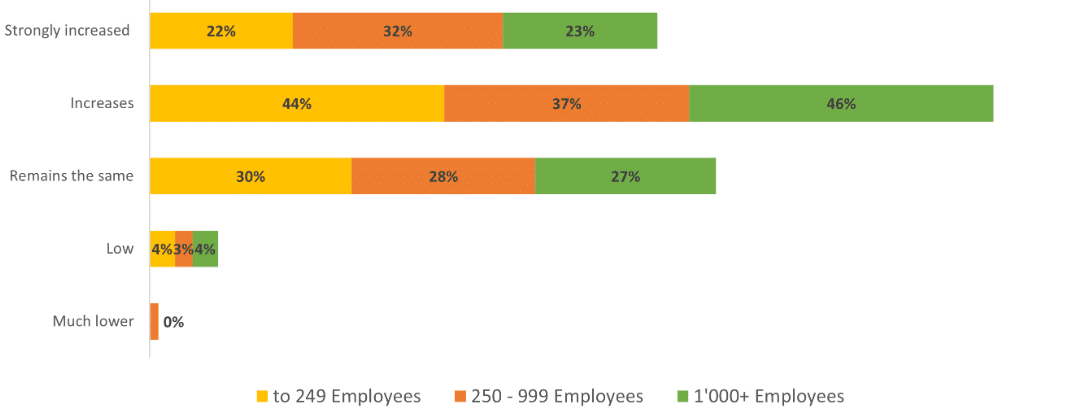
Further questions included in the BPM study
In addition to the topics already explained, the study also provides answers to the following questions:
- Where is the focus of IT investments in the next year?
- How do you support the implementation/execution of your processes?
- What software-based tools do you use to automate your processes?
- And much more
Summary
The study results clearly show that the boom of business process management continues. Companies have realized that a sound knowledge of processes is the foundation for effectively meeting the demands of our time, resulting from increasing competition and an ever faster pace of global innovation. With the right tool support, as well as the right strategies to implement BPM in your organization, you can unleash the true value of business process management.
If you are interested in more details on the ZHAW School of Management and Law’s free BPM study, you can download it for free. For the right tool support for your BPM initiatives, we recommend you try our leading BPM suite ADONIS with the free BPM tool.
Source:
Business Process Management Study 2023, Analysis of the 2022 status quo and developments over the last 11 years in the context of BPM, A study by the Institute of Information Systems in cooperation with BOC Group, Authors: Tim Geppert, Björn Scheppler, Felix Meentken, Sandro Gerussi & Elke Brucker-Kley
Get our weekly updates.
Never miss the freshest content.







